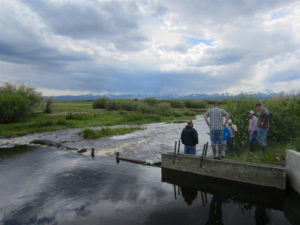Montana Ground Water Investigation Program
Q&A with Jenna Dohman, Montana Bureau of Mines and Geology Hydrogeologist
Montana Ground Water Investigation Program
Jenna Dohman’s work with the Montana Bureau of Mines and Geology’s Montana Ground Water Investigation Program includes a groundwater monitoring project on the Big Hole River, where most private land agricultural irrigation involves flood-irrigating grass hay. Dohman is measuring surface water at 16 sites near Glen, Montana, as well as the water levels in 47 wells near the area, and using infrared cameras to monitor temperatures where groundwater enters the Big Hole River. She is also studying irrigation recharge in the area by measuring water that gets past the root zone of the plants being irrigated.
Q: What was the result that surprised you the most (so far, considering your data analysis is ongoing)?
A: During the summer, we found that canal water returning to [the Big Hole River] was the same temperature or even cooler than the river. Although the canals generally warmed up along their path, these canals happened to be impounded prior to release back to the river. At one site, water was released from the bottom of the pooled area and was consistently cooler than the river, day and night.
Q: How can irrigators and other water users/managers work together using this data?

Flood irrigation infrastructure on Montana’s Big Hole River.
A: Our thermal data suggests that changes to irrigation infrastructure could help return cooler water to river systems, without impacting an irrigator’s production. We’re also seeing that groundwater recharge results primarily from flood irrigation and canal leakage (from unlined canals), but not from pivot irrigation. Depending on overall goals, these irrigation methods could be powerful tools to manage water in a particular area.
Q: What research is needed to better paint the picture of water use and return flows in the West?
A: There is a lack of data on how much groundwater recharge is directly caused by irrigation, whether it be from active irrigation (flooding, pivots) or from canal leakage. However, setting up a field study to do this is time-intensive and requires strong partnerships with landowners. Other studies have used models to assess these types of irrigation changes, but they rely heavily on landcover data and estimated crop water use. Validating these models with field data would help further our understanding of irrigation impacts on groundwater recharge.
Q: What technology or data-gathering techniques are needed to help irrigators make informed decisions at smaller scales? Is there technology that exists that should be more widely used/accessible?
A: Most irrigators in my experience have a strong understanding of how their water use impacts the local water system, but in many cases, they don’t have hard data. For example, many irrigators know that their canals lose water, but they don’t know how much. Creating a rating curve from canal water levels and discharge measurements could provide that information. This would allow landowners to show additional benefits from their irrigation (groundwater recharge) and might influence changes to irrigation practices down-gradient. For instance, one landowner we work with flood irrigates above his pivot field, which results in less irrigation water needing to be applied through his pivot in the lower field.
Q: If you could provide one takeaway for Montana water management as a result of this study, what would it be?
A: Although there’s been a big push towards pivot irrigation due to its more efficient use of water and lower labor requirements, flood irrigation has some notable benefits. Our data shows it provides more groundwater recharge, storing that water in the ground for later use or potentially supporting river flows. In the right environments, where surface water is used for irrigation and groundwater has a clear connection to river systems, it might be useful to create incentives for irrigators to keep their lands in flood irrigation.

